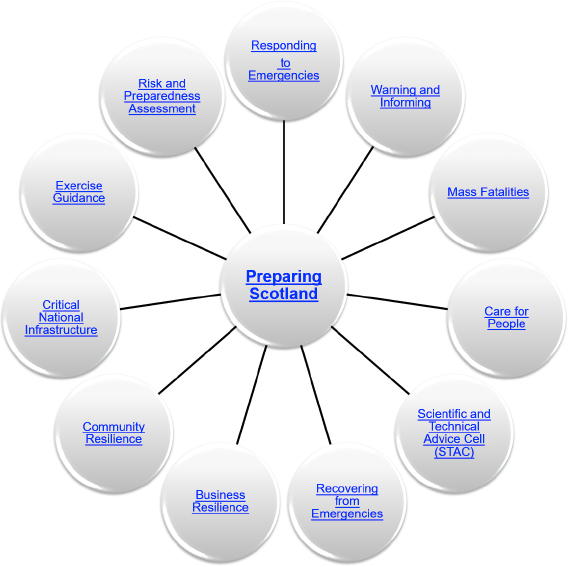This document is part of the Preparing Scotland suite of guidance. Preparing Scotland guidance is set out as a "Hub and Spokes" model. The central Hub incorporates the philosophy and principles of resilience in Scotland, governance structures, regulatory guidance and recommended good practice. The spokes, of which this guidance is part, provide detailed guidance on specific matters, see diagram below. This guidance relates to Responding to Emergencies.

Users who are familiar with the structures and processes of resilience in Scotland may use this Responding to Emergencies guidance in isolation. For those unfamiliar with these structures it is recommended that this guidance is read in conjunction with the central hub, Preparing Scotland.
Purpose of Guidance
Preparing Scotland, Responding to Emergencies, is not intended to be an operations manual, but is instead guidance to responders assisting them in planning and response. It establishes good practice based on professional expertise, legislation and lessons learned from planning for and dealing with major emergencies at all levels. It is intended to be a flexible and responsive document, able to respond to new hazards and threats as well as those more frequently encountered.
Legislation
Preparing Scotland is underpinned by the principal legislation involved, the Civil Contingencies Act 2004 (the Act) and the Civil Contingencies Act 2004 (Contingency Planning) (Scotland) Regulations 2005/Civil Contingencies Act 2004 (Contingency Planning) (Scotland) Amendment Regulations 2013 (the Regulations).
Responders
The Act and the Regulations outline the key organisations responsible for ensuring the effective management of emergencies in Scotland. These are:
Category 1 Responders:
- Local Authorities
- Police
- Fire
- Ambulance
- Health Boards
- Scottish Environment Protection Agency
- Maritime and Coastguard Agency.
Category 2 Responders:
- Electricity Operators
- Gas Suppliers
- Scottish Water
- Communications Providers
- Railway Operators
- Airport Operators
- Harbour Authorities
- NHS National Services Scotland
- Health and Safety Executive.
In addition to the above, other agencies can have an important role in the context of resilience. These include but are not confined to:
- the military
- the Crown Office and Procurator Fiscal Service (COPFS)
- Transport Scotland
- commercial organisations
- the Scottish Government
- the voluntary sector
Duties
The legislation places a number of legal duties upon Category 1 responders. These are, in brief:
- Duty to assess risk
- Duty to maintain emergency plans
- Duty to maintain business continuity plans
- Duty to promote business continuity1
- Duty to communicate with the public
- Duty to share information
- Duty to co-operate.
For Category 2 responders the basic legislative principle is that they must co-operate with Category 1 responders in connection with the performance of their duties, including the proper sharing of information.
Structures
The Regulations2 outline the structure within which cooperation to meet these legal duties should be undertaken, namely the Regional Resilience Partnerships (RRP). The RRPs do not have the power to direct individual members in the undertaking of their duties.
There are three RRPs, the North of Scotland, East of Scotland and West of Scotland.
To support working arrangements and maintain effective local liaison, the RRP areas have been sub-divided into 12 Local Resilience Partnerships (LRPs), taking account of existing Local Authority and, where applicable, Health Board boundaries.
1 This duty applies to Local Authorities only
2 The Civil Contingencies Act 2004 (Contingency Planning) (Scotland) Amendment Regulations 2013; Reg: 2(2)(a)


